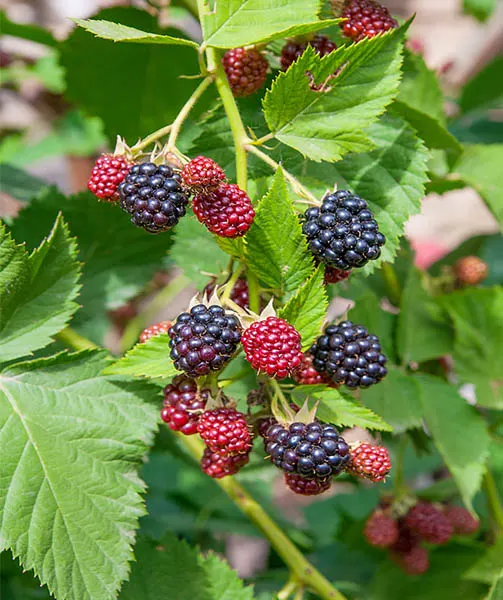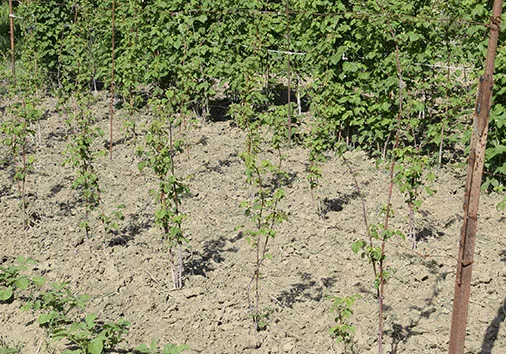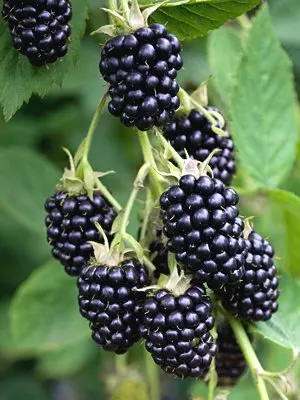When we received this week’s garden tip article from Stacy Sulinger, it made us long for the taste of a fresh homemade blackberry pie. Or perhaps a scoop of vanilla ice cream with fresh raspberries draped over the top!
Both blackberries and raspberries are members of the bramble family, and are a fantastic perennial crop for home gardeners to grow. Not only are they easy to plant and maintain, a single planting can live and thrive for 15 to 20 years or more.
Stacy, who hails from the western Missouri area, certainly loves her blackberries and raspberries! And we are so glad that she shared her growing knowledge and techniques today. So let’s grow some blackberries and raspberries with Stacy!

How I Grow My Blackberries and Raspberries
Stacy Sulinger – Western Missouri
Growing Zone : 6

I love the taste of fresh blackberries and raspberries! I use them in pies, cobblers, tarts, jellies and just about anything I can put them in or on!
I think what I love best about growing your own is that you simply can’t beat the flavor of home-grown.
When I see raspberries or blackberries in the stores, they may look perfect, but they simply lack flavor! Not so when you grow your own. And it’s really easy too! I am by no means an expert, but I love growing them.
I thought I would share how I grow mine, and I hope it helps others who might want to as well.
I wish I had some better pictures to show, but it’s winter here now and there just isn’t much to see! I will send in updates this summer when I have more photos.
Selecting Location
Brambles need to receive a minimum of 6 hours of daily sunlight. If they can get 8 or more, they will do even better. They do not do well in overly wet areas, so select a spot that is well drained.
Sloping hillsides, or slightly mounded soils are great locations to grow both blackberries and raspberries. I have mine on a slight slope in my backyard and they have really done well.
Soil Preparation
Brambles will grow in almost all soil types, but they prefer slightly acidic conditions. If you have clayish soil, or a mixture of sand and clay – they will thrive beyond belief. Adding in a bit of compost and sand to the planting area can help get them off to a great start too. To be honest, I have never had to do much to mine. About the only fertilizer I give them is a bucket of compost I put around each crown base in the each spring.
Planting and Support
When it comes to support, what you will need all depends on the variety you choose. There are upright and trailing brambles. I personally think the trailing have the best flavor and produce the most, so that is what I grow.
A trailing bramble can grow 10 to 20 feet long. I use a few posts with wire strung between them like you would see in a vineyard. You can also use a trellis. Simply train them as they grow. I use twine to tie mine to the supports.

If you do not have wide open space, you can plant the erect type of each. I just have always stuck with trellising stock because they produce so much and I can keep them trained.
I plant raspberries and blackberries the same way, putting them in a slight mound about 2 inches above the soil line. I planted 4 plants of each about 6 feet apart of each, but I could have spaced them even more. They have filled in more than I ever thought they would. They are in their 6th year now, and we routinely get 10 to 15 quarts of each. Sometimes a lot more, sometimes a little less during dry years. For erect types, you can plant them a foot or two apart.
Most newly planted blackberries and raspberries will not fruit the first year. Some people don’t realize that brambles produce on two-year canes. One grows the first season, then the fruit canes grow the next. It’s only the first year that you won’t have fruit, because new fruiting canes for the next year grow each season as well after the first. It all may sound confusing, but it just means you won’t have fruit your first year! 🙂
Long Term Care
You do not need to prune at all the first year. But starting the second year, remove the old shoots that are dying off, and allow the new “alive” shoots to come on for the next year’s harvest. They have really not been hard at all to keep producing. I am going to try a couple of new erect varieties this year that are supposed to have improved flavor. I will keep you updated!
Thanks for letting me share!
Blackberry Links : Apache (erect) Natchez Thornless (Vining)
Raspberry Links : Mysore Black Raspberry Red Raspberry Nova
Share Your Gardening Article With The World!
Thank you Stacy for sharing! And for all gardeners out there – let us know how you grow your favorite flowers, shrubs or vegetables, and have your article featured here!
All you need to do is email us today at info@thisismygarden.com. You can also use our “Feature My Garden Tip” button at the top of the website for your entry. Help make This Is My Garden the best garden site around and share your garden knowledge with fellow gardeners!

